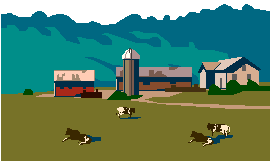

To send a message to an author, click on the author's name at the end of the article.
This Month in Ag Connection | Ag Connection - Other Issues Online

Growing conditions in 2009 has produced larger soybean seed in some varieties and areas. Most seed is sold by weight so seed count per bag may be lower than usual. Some seed companies are now selling soybean seed by seed count. If you are buying seed by the bag, your seed cost per acre may be greater and vary significantly by variety and its inherent seed size.
Small and large seed of the same variety have the same yield potential. Under most conditions, seed size does not affect germination or emergence. There are a few exceptions for larger seed. Larger seed may be able to survive adverse conditions longer due to a greater reserve of energy. On the other hand, larger seed may have a more difficult timeemerging under adverse conditions due to the size of the cotyledons, and may require more moisture for germination which under dry conditions could be a problem. Planters and drills should be calibrated to adjust for larger soybean size to prevent under seeding. Soybeans can compensate to some degree for lower populations but the uniformity of stand is very critical. Select varieties on performance, placement, and seed quality, not seed size.
Research from various sources indicates that there is a yield advantage for 15-inch rows compared to 30-inch rows and very little difference in yield between drilled and 15 inch rows. The optimum seeding depth for the majority of soybeans and environmental conditions is 1 to 1.5 inches.
Seeding rate is a controversial topic. Soybean seed prices were only 7 to 10 cents per 1000 seeds before Roundup Ready soybeans. Now they are 35 to 55 cents per 1,000 seeds. That makes higher seed prices about seven to eight times higher than 15 years ago. The yield curve on soybeans indicates that response to population is fairly flat from 125,000 to 225,000 seeds per acre. The goal is to have at least 100,000 plants per acre fairly uniformly distributed at harvest time. Results from the University of Illinois compared seed cost versus yield, using a range of 15 to 45 cents per 1000 seeds and comparing to yields from a recent study, they found that the most economical seeding rate varied by 26,000 seeds per acre. Based on this study, the optimum seeding rate, when seed cost is 25 to 45 cents per 1000 seeds, falls between 100,000 and 129,000 seeds per acre. With current seed costs, using extra seed as insurance to compensate for things like major catastrophes that don't occur very often may not be economical.
Source: Wayne Crook, Agronomy Specialist
This Month in Ag Connection | Ag Connection - Other Issues Online
March and April is the time many cow-calf producers purchase new bulls. Managing these young bulls between now and the beginning of the breeding season is critical to their longevity in your herd. Chris Zumbrunnen, MU Extension livestock specialist, wrote an article on bull management. Below are a few ideas from his article.

Many of these young bulls have been in feeding programs where they have been fed to gain 2 to 4 pounds per day from weaning to sale day. It is important to keep young bulls gaining about 2 pounds per day from the time they arrive on your place until you turn them in with the cows. They are still growing and maturing and need extra energy reserves going into the breeding season. At the beginning of breeding season a bull should be in a body condition score of 6. Don't forget about bulls after you turn them in with the cows either. You may need toprovide some supplement in the pasture to keep them from loosing too much condition.
Pay attention to feet and leg problems. Long or curled hooves could be a result of nutrition, genetics or acombination of the two. Bulls with this problem may not stay too long in the herd. Bulls need to be able to travel freely. A bull walking on smooth, level ground should put his rear hoof down in the track left by the front hoof.
Make sure you know what diseases the bulls have been vaccinated against. Bulls should have been vaccinated against both respiratory and reproductive diseases. Also check on the parasite control and do that if necessary.
Your bulls should all pass a breeding soundness exam. This will ensure they are able to do the job you bought them to do. Be sure the bull is producing adequate sperm with high motility and does not have a large number of abnormal cells.
If problems are detected, it is still not too late topurchase a new bull, but time is beginning to get short. Avoid the temptation to just get a bull to "settle the cows". Much of the financial health of yourbusiness depends on getting as many pounds of calf sold from your farm as possible. Poor performing bulls or bulls with poor expected progeny difference's (EPD's) are a liability that most producers can't afford.
Source: Gene Schmitz, MU Extension Livestock Specialist
This Month in Ag Connection | Ag Connection - Other Issues Online
The need to add supplement nitrogen (N) as the season progresses is often overlooked. Unfortunately the soil test recommendations for gardens are partly to be blamed. It does notaccount for yield estimates ordifferent crops' specific preferences for N. Nitrogen recommendations are simplified to one application, generally at planting, based on soil organic matter.
If you have a commercial scale garden, use the sample information form for Commercial Fruits, Vegetables and Turf ( MP 727) when submitting your soil fortesting, which would provide crop specific recommendations. If organic matter is high enough (5% or greater), no nitrogen is recommended.
Many soils are below this, thus a side-dress recommendation of N is often advised, especially for longer season vegetables (tomatoes) or those with high nitrogen needs (corn). In the MU Guide 6950 'Steps in Fertilizing Garden Soil: Annual Flowers andVegetables' (G6950 Steps in Fertilizing Garden Soil: Vegetables and Annual Flowers | University of Missouri Extension)
Table 2 addresses the specific recommendations.
Side-dressing applies fertilizer efficiently to the soil at the side of a row of seeds or plants. It can be done at planting or as an extra application later in the growing season to help provide a uniform supply of nutrients throughout the season. This is often needed because many chemical fertilizers are very soluble, so the initial application may leach beyond the root zone before the growing season ends. For field crops and commercial gardens, a cultivator fitted with a special attachment to distribute the fertilizer is used to side-dress. For the smaller spaces of home gardens, side-dressing is often done manually.
The usual rate for a side-dress application in the garden is 5 tablespoons per 10 feet of row of a high-nitrogen fertilizer such as ammonium nitrate or urea. Asparagus requires twice as much, and potatoes should receive about 7 tablespoons per 10 feet of row. Place the fertilizer in bands about 6 inches to both sides of the rows, then rake it in and water. A combination of chemical fertilizer, organic fertilizer, and mulch also works well. The chemical fertilizers give the initial boost required by young plants; organic fertilizers provide nutrients uniformly throughout the season; and mulch keeps the soil more evenly moist and the nutrients more uniformlyavailable.
Source: James Quinn, MU Extension Horticulture Specialist
This Month in Ag Connection | Ag Connection - Other Issues Online
Vegetative Environmental Buffers (VEB)s are getting more attention. It's not just that we have endured a winter characterized as the one of the coldest in 30 years. Several factors are bringing wind breaks, shelterbelts or now VEBs into a greater importance.
Windbreaks have long been a typical and attractive part of farms in the northern Great Plains. Now more may become of part of central and southern US farms involved in livestock production.
Several factors are pushing farmers to VEBs. There is the Clean Air Act compelling larger animal farms to manage livestock odors. Smaller livestock farms will also benefit from proactive public relations efforts with neighbors.
Recent data indicates less than 2% of the US population is actively involved in farming and the rest are typically 3 generations removed from the farm. This means most or our citizens have little working knowledge of farm life and literally "turn up their noses" at livestock production.
Vegetative Environmental Buffers are sustainable, attractive, environmentally effective and an easily established solution. Some of the advantages of VEBs to manage odors are:
The VEBs still give the classic advantages having made windbreaks popular for so long. They can be found in the Guide Sheet, G5900 - Planning Tree Windbreaks in Missouri.
There are other considerations differing from past layouts for windbreaks or shelterbelts. Odors are produced all year. The classic layout used to be only along the northern side of a farmstead. VEBs should surround the animal production area; however they do not have to be multi-row plantings on all sides.
An initial piece needed before laying out a VEB are "wind roses" for the farm. Wind roses show thedirection and speed of local wind. At least two are needed for spring/summer and fall/winter winds. This will give the livestock producer knowledge of where to place higher concentrations of trees and shrubs for optimum odor abatement.
Sources: Jim Jarman, MU Extension Agronomy Specialist
This Month in Ag Connection | Ag Connection - Other Issues Online

Morgan Co. - April 6 & 7
Contact: Morgan SWCD (573) 378 - 5822 Ext. 3
Benton Co. - April 14 & 15
Contact: Benton SWCD - (660) 547-2351 Ext. 3
Cole & Moniteau Co. - May 4,5,&6
Contact: Cole SWCD - (573) 893 -5188 Ext. 3
Osage Co. (Tri-County School) - May 13 &14
Contact: Osage SWCD - (573) 897-3797 Ext. 3
Callaway Co. - Sept.1 & 2
Contact: Callaway SWCD (573) 592-1400 Ext. 3
This Month in Ag Connection | Ag Connection - Other Issues Online
Beginning in 2010 more taxpayers are eligible to convert their traditional IRAs or other taxable retirement accounts to Roth accounts. Prior to 2010, only taxpayers with less than $100,000 of modified adjusted gross income qualified for making this conversion. Modified adjusted gross income is basically your adjusted gross income, not including the income from the conversion and not including any deductions for traditional IRA contributions. Starting in 2010 there is no modified adjusted gross limitation.
Conversions can be completed in one year or spread over a number of years to avoid being forced into a higher tax bracket. For conversions completed during 2010, the taxpayer may elect to report the income as 2010 income or elect to report the income equally in the 2011 and 2012 tax years.

Factors that tend to favor this conversion are:
More information on converting your IRA is available in the free IRS Publication 590 "Individual Retirement Arrangements".
This publication can be obtained by calling the IRS toll free number 1-800 TAX FORM or from the Web: http://www.irs.gov/pub/irs-pdf/p590.pdf
Source: Parman R. Green, MU Extension Ag Business Mgmt. Specialist
This Month in Ag Connection | Ag Connection - Other Issues Online
Publishing Information
Ag Connection is published monthly for Northeast and Central areas of Missouri producers and is supported by the University of Missouri Extension, the Missouri Agricultural Experiment Station, and the MU College of Agriculture, Food and Natural Resources. Managing Editor: Mary Sobba.